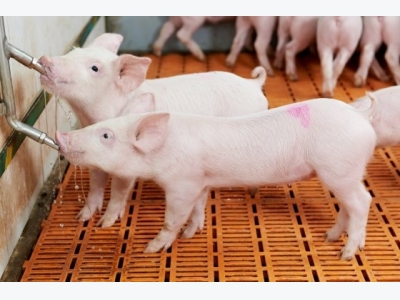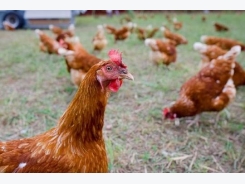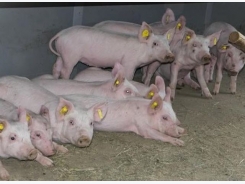Antibiotic reduction in animal production

The challenges seem daunting and the predictions of increasing post-weaning diarrhoea in piglets, increased dairy cow mastitis or necrotic enteritis in poultry when antibiotics are no longer available in production systems makes us worried. However, these worries may be unwarranted.
Photo: Dreamstime
We hear it all the time, ‘stop using antibiotics’, ‘reduce antibiotic use’, and scary predictions that antibiotics will stop working and bring us back to the pre-antibiotic era. It sounds like our ability to prevent disease, treat disease and maintain a cost-effective production will be taken away from us.
Antibiotics have been, and are, the best treatment options for serious bacterial disease. However, every single time antibiotics are used, whether prudent therapeutic or non-prudent growth promoting or prophylactic, there is a risk for emergence of antimicrobial resistance (AMR) and for future health and safety of our animals and humans. The EU has recently published ‘the European One Health action plan against antimicrobial resistance’ (European Commission, 2017). This action plan will enable and motivate countries to provide supportive actions including infection prevention, biosecurity measures and control practices in human healthcare and in animal husbandry in order to reduce infections and thus the need for antimicrobials.
A healthy animal production system
The greatest flaw of animal production systems is that they have been designed and utilised in a way that requires antibiotics to maintain health and welfare. The majority of antibiotics used in animal production are not used to treat sick animals, but are used to treat unhealthy production systems. Although there is a continuous quest for alternatives to antibiotics, decades of research have provided few good alternatives and therefore we need to seek solutions for health, rather than treatments for unhealthy production systems. To minimise reliance on antibiotic solutions, there needs to be a shift in focus from alternative drugs or treatments to optimising production systems so that prophylactic and metaphylactic treatments become redundant. This will, in the long term, be cost-effective, since healthy production systems generate healthy animals and healthy economies. The goal to reduce antibiotic use should be rephrased to a goal to produce healthy production systems. We need to look at this goal as a challenge and not as a threat and take on the challenge with passion and determination.
We have the knowledge and tools to create these systems and many producers can demonstrate high productivity and cost-effectiveness in production systems that have eliminated prophylactic and metaphylactic use of antibiotics. We can all strive for a higher level of health and productivity, and provide the quality products that modern day consumers are requesting. It is time for us to stop looking for alternatives to antibiotics prior to taking action. Unfortunately, many professionals and stakeholders in the industry are promoting and holding on to antibiotic solutions as measures to maintain animal health. However, more and more evidence is showing that antibiotic reduction is cost-effective. Therefore, spokespeople, health professionals, regulatory and political institutions, universities and other stakeholders must all support a healthy development of the animal production sector.
Team work, audits, motivation
There is not a lack of knowledge as to how to raise a healthy animal and maintain a healthy herd or flock. The challenge for the producer is to determine the key factors that first needs to be addressed and find motivation to get started. A key to success in an antibiotic reduction programme is to assemble a team including veterinarians, nutritionists, consultants (governmental, academic or industry), building engineer experts, owners, managers and workers. A new set of eyes with different perspectives can evaluate potential weaknesses and strengths of the production system. A reasonable timeline and multiple targets and goals to achieve, need to be determined and the programme needs to be farm-adapted. Audits to establish the baseline current situation and recurrent audits to monitor progress are important to keep the momentum going and to re-evaluate progress and targets. Systems to benchmark the production against peers and targets that are objective and clearly defined are important to keep motivation and progress going.

Studies have indicated that routine antibiotic treatments may be harming calf health. Photo: Mark Pasveer
Optimising health and production
In an effort to reduce antimicrobial use, there is an excellent opportunity to improve production animal health and productivity. There are many resources and information sources to assist the individual producer to optimise and maintain high levels of health and welfare in production systems that do not necessitate antimicrobial medication. European pig health experts recently ranked alternative solutions to antimicrobials. Improvements in biosecurity, increased use of vaccination, use of zinc/metals, feed quality improvement and regular diagnostic testing combined with a clear action plan were perceived to be the most promising alternatives to antimicrobials in industrial pig production based on combined effectiveness, feasibility and return on investment.
Biosecurity is critical to prevent introduction of disease-causing organisms on a farm and prevent the spread within a farm. The poultry industry has for a long time embraced the importance of biosecurity, pig production has come far, whereas the importance of biosecurity has not fully been embraced in dairy and beef production. Ghent University has shown that higher levels of biosecurity in pig farms are associated with higher levels of production, and decreased antimicrobial use and resistance. The Ghent University team has made an online tool available whereby poultry and pig farms can evaluate and benchmark their biosecurity, and this is also being developed for bovine productions.
Respect physiological needs
The herd-level immunity, individual gut health and systemic immunity, nutritional status, stress-levels, and environmental conditions all interact. A big challenge is raising healthy young animals in artificial production systems with high animal density. It is imperative to respect the physiological development of the young animals and not just try to make them adapt to our systems.
A healthy gut with a balanced microbial composition is critical for optimal digestion and nutrient uptake. The most important tool for good gut health is to provide the best feed possible that meets the nutritional needs for the specific age and stage of production. Multi-phase feeding systems and precision feeding are valuable tools not only for productivity, but also for health. Appropriate feed for the various stages of development is very important and weaning times and weaning systems in piglets and dairy calves need to allow the animals to transition from milk to grain-based diets. Dietary supplements such as organic acids, prebiotics, probiotics, and enzymes are also valuable tools in antibiotic-free production systems.
Transport and trade in live animals is a practice that imposes high physiological stress on the animals and creates a high risk of spread of diseases and this creates a need for antimicrobial medication to protect the animals from disease. The current production systems have enabled live animal transport and trade to the detriment of the animals. Transport of young animals often involves prophylactic antibiotic medications. These production systems need to take measures to minimise all unnecessary transport of animals during rearing. However, there are strengths in segregated production systems, and therefore more focus should be placed on the ability to minimise stress and spread of disease through animal trade and transport and minimise the length of transports.

Reducing antimicrobial use is an opportunity to improve animal helath and productivity. Photo: Bart Nijs
Stocking density, hygienic conditions of housing, bedding material, temperature, humidity and air quality are just a few environmental conditions that have a huge influence on health and welfare. The ideal environmental temperature is perfectly adapted to the age and weight of the animals. Good air quality and ventilation is essential to keep animals healthy and vigorous. A warm, moist environment is also a perfect environment for pathogenic bacteria to thrive and propagate. Overstocking is very common and this impacts the environmental temperature and hygiene, and many times it leads to the reduction in cleaning and disinfection between batches of animals. Overcrowding also imposes a social stress on the animals as there may be insufficient eating and resting space. Animal welfare has a big impact on production efficiency and health. Although most of us know about all these stressors for animals, it is very common to come into farms where the management and stress factors leading to disease are not corrected, but the animals are fed antibiotics to reduce disease and poor performance.
Good systemic immunity is critical
Vaccines have proven to be crucial and very cost-effective in preventing the onset and spread of infectious diseases and thereby have great potential to reduce the incidence of AMR. The European Commission states in the One Health Action Plan that vaccines should be boosted even further to decrease the use of antimicrobials in those sectors. However, immune enhancing measures are not limited to vaccinations but include numerous other factors such as genetic selection, pathogen-free animals, nutrition, mycotoxin prevention, stress reduction, stocking density and environmental factors. Biosecurity and increased use of vaccination were perceived to be the most promising alternatives to antimicrobials in industrial pig production based on combined effectiveness, feasibility and return on investment by the European pig health experts.
Industry-initiatives to assist the farm in developing a good disease reduction and prevention programme are a great resource for farmers, since immunity and vaccinations are complicated concepts. MSD Animal Health has recently launched ‘Time to Vaccinate’, a new programme designed to help farmers better appreciate the benefits of vaccinating their cattle. Vaccinations, as part of an overall prevention programme, can greatly contribute to the reduction in severity and frequency of infectious diseases, including the need for antibiotics to treat infections. Increasing the vaccination rate and therefore the immunity against endemic pathogens, allows improved productivity, improved health and welfare.
Maintaining good health, antibiotic-free
Between 2009 and 2014 the use of antibiotics in Dutch livestock decreased by 58%. This does not appear to have affected farm profits: the animal husbandry sector did not diminish in size and the average technical and economic results do not appear to have worsened. Since Belgium started their initiative to reduce antimicrobial use and resistance in 2011 through the creation of AMCRA (Center of expertise on Antimicrobial Consumption and Resistance in Animals), there has been a 20% decrease in overall antimicrobial use. Professor Jeroen Dewulf, founding board member of AMCRA stated “I have not received any information from the field regarding a reduction in productivity. On the contrary, productivity continues to increase as it has done in the last 20 years. I have no feedback what so ever that there would be a negative impact of the reduction in antibiotics use on productivity or animal welfare.”
A recent European study assessed, across four countries (Belgium, France, Germany and Sweden), the technical and economic impact of herd-specific interventions in 70 farrow- to-finish pig farms aiming at reducing antimicrobial usage in pig production while implementing alternative measures.
A median reduction of 47% of antimicrobial use treatments was achieved corresponding to a 31% median reduction of antimicrobial expenditures. The median change in net farm profit among Belgian and French farms was estimated to be € 4.5 or € 1.2 per sow per year using the deterministic and stochastic models, respectively. The improved profitability was mostly due to change in feed conversion ratio and daily weight gain rather than by a change in antimicrobial expenditures. This clearly indicates that antibiotic reduction can be cost-effective.
In dairy production, mastitis treatments are responsible for most antibiotics used on a dairy farm. Dry cow therapy (DCT) is the most frequently used prophylactic therapy in dairies. Blanket dry cow therapy (BDCT), ie treating all cows prior to calving, has been used on many dairy farms. Injecting a cow with no signs of sub-clinical mastitis or previous history of mastitis with antibiotics is not prudent use of antibiotics, and can even lead to mastitis. Teat sealants in combination with selective dry cow therapy (SDCT) based on diagnostics and mastitis history is recommended. SDCT guided by on-farm milk culture has been shown to be equally successful in reducing mastitis as BDCT. Preventing mastitis is more cost-effective than treating clinical cases and reduces antibiotic use drastically, however the cost-benefit analysis of various DCT vary largely between studies due to the various factors involved. Another area where antibiotic use is too high on many dairy farms is in the young stock. In pre-weaned dairy calves reared on the dairy it has been shown that antibiotics added to the milk/milk replacer and routine treatments of diarrhoea with antibiotics was detrimental for dairy calf health, daily weight gain and not cost-effective. The study indicated that if antimicrobials were used only for diarrhoea cases with fever, inappetence, or depression and no in-milk antimicrobials were used, a $ 10 per calf savings could be realised.
There is thus clear evidence that antibiotic reduction is cost-effective and in general does not lead to more disease and productivity losses. For every farm, there may be temporary and unique challenges to address in the process of eliminating all unnecessary antibiotic use. Do not let temporary set-backs or minor obstacles deter you from the industry’s mission to safeguard antibiotics for the future. Make use of government, academic, industry and/or your herd veterinarian knowledge and advice to start and continue towards the target goal to optimise production health.
References available on request
Có thể bạn quan tâm
Phần mềm

Phối trộn thức ăn chăn nuôi

Pha dung dịch thủy canh

Định mức cho tôm ăn

Phối trộn phân bón NPK

Xác định tỷ lệ tôm sống

Chuyển đổi đơn vị phân bón

Xác định công suất sục khí

Chuyển đổi đơn vị tôm

Tính diện tích nhà kính

Tính thể tích ao hồ




 Mekong farms urged to use tech
Mekong farms urged to use tech  EAHE systems may cool livestock facilities effectively
EAHE systems may cool livestock facilities effectively